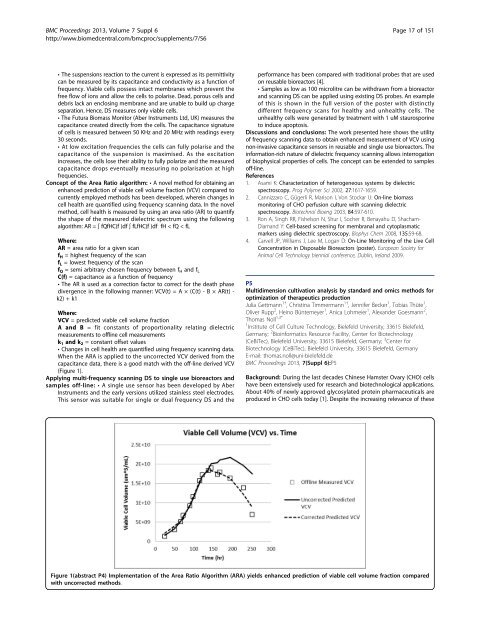Download PDF (all abstracts) - BioMed Central
Download PDF (all abstracts) - BioMed Central
Download PDF (all abstracts) - BioMed Central
You also want an ePaper? Increase the reach of your titles
YUMPU automatically turns print PDFs into web optimized ePapers that Google loves.
BMC Proceedings 2013, Volume 7 Suppl 6<br />
http://www.biomedcentral.com/bmcproc/supplements/7/S6<br />
Page 17 of 151<br />
• The suspensions reaction to the current is expressed as its permittivity<br />
can be measured by its capacitance and conductivity as a function of<br />
frequency. Viable cells possess intact membranes which prevent the<br />
free flow of ions and <strong>all</strong>ow the cells to polarise. Dead, porous cells and<br />
debris lack an enclosing membrane and are unable to build up charge<br />
separation. Hence, DS measures only viable cells.<br />
• The Futura Biomass Monitor (Aber Instruments Ltd, UK) measures the<br />
capacitance created directly from the cells. The capacitance signature<br />
of cells is measured between 50 KHz and 20 MHz with readings every<br />
30 seconds.<br />
• At low excitation frequencies the cells can fully polarise and the<br />
capacitance of the suspension is maximised. As the excitation<br />
increases, the cells lose their ability to fully polarize and the measured<br />
capacitance drops eventu<strong>all</strong>y measuring no polarisation at high<br />
frequencies.<br />
Concept of the Area Ratio algorithm: • A novel method for obtaining an<br />
enhanced prediction of viable cell volume fraction (VCV) compared to<br />
currently employed methods has been developed, wherein changes in<br />
cell health are quantified using frequency scanning data. In the novel<br />
method, cell health is measured by using an area ratio (AR) to quantify<br />
the shape of the measured dielectric spectrum using the following<br />
algorithm: AR = ∫ fQfHC(f )df ∫ fLfHC(f )df fH < fQ < fL<br />
Where:<br />
AR = area ratio for a given scan<br />
f H = highest frequency of the scan<br />
f L = lowest frequency of the scan<br />
f Q = semi arbitrary chosen frequency between f H and f L<br />
C(f) = capacitance as a function of frequency<br />
• The AR is used as a correction factor to correct for the death phase<br />
divergence in the following manner: VCV(t) = A × (C(t) - B × AR(t) -<br />
k2) + k1<br />
Where:<br />
VCV = predicted viable cell volume fraction<br />
A and B = fit constants of proportionality relating dielectric<br />
measurements to offline cell measurements<br />
k 1 and k 2 = constant offset values<br />
• Changes in cell health are quantified using frequency scanning data.<br />
When the ARA is applied to the uncorrected VCV derived from the<br />
capacitance data, there is a good match with the off-line derived VCV<br />
(Figure 1).<br />
Applying multi-frequency scanning DS to single use bioreactors and<br />
samples off-line: • A single use sensor has been developed by Aber<br />
Instruments and the early versions utilized stainless steel electrodes.<br />
This sensor was suitable for single or dual frequency DS and the<br />
performance has been compared with traditional probes that are used<br />
on reusable bioreactors [4].<br />
• Samples as low as 100 microlitre can be withdrawn from a bioreactor<br />
and scanning DS can be applied using existing DS probes. An example<br />
of this is shown in the full version of the poster with distinctly<br />
different frequency scans for healthy and unhealthy cells. The<br />
unhealthy cells were generated by treatment with 1 uM staurosporine<br />
to induce apoptosis.<br />
Discussions and conclusions: The work presented here shows the utility<br />
of frequency scanning data to obtain enhanced measurement of VCV using<br />
non-invasive capacitance sensors in reusable and single use bioreactors. The<br />
information-rich nature of dielectric frequency scanning <strong>all</strong>ows interrogation<br />
of biophysical properties of cells. The concept can be extended to samples<br />
off-line.<br />
References<br />
1. Asami K: Characterization of heterogeneous systems by dielectric<br />
spectroscopy. Prog Polymer Sci 2002, 27:1617-1659.<br />
2. Cannizzaro C, Gügerli R, Marison I, Von Stockar U: On-line biomass<br />
monitoring of CHO perfusion culture with scanning dielectric<br />
spectroscopy. Biotechnol Bioeng 2003, 84:597-610.<br />
3. Ron A, Singh RR, Fishelson N, Shur I, Socher R, Benayahu D, Shacham-<br />
Diamand Y: Cell-based screening for membranal and cytoplasmatic<br />
markers using dielectric spectroscopy. Biophys Chem 2008, 135:59-68.<br />
4. Carvell JP, Williams J, Lee M, Logan D: On-Line Monitoring of the Live Cell<br />
Concentration in Disposable Bioreactors (poster). European Society for<br />
Animal Cell Technology biennial conference, Dublin, Ireland 2009.<br />
P5<br />
Multidimension cultivation analysis by standard and omics methods for<br />
optimization of therapeutics production<br />
Julia Gettmann 1† , Christina Timmermann 1† , Jennifer Becker 1 , Tobias Thüte 1 ,<br />
Oliver Rupp 2 , Heino Büntemeyer 1 , Anica Lohmeier 1 , Alexander Goesmann 2 ,<br />
Thomas Noll 1,3*<br />
1 Institute of Cell Culture Technology, Bielefeld University, 33615 Bielefeld,<br />
Germany;<br />
2 Bioinformatics Resource Facility, Center for Biotechnology<br />
(CeBiTec), Bielefeld University, 33615 Bielefeld, Germany; 3 Center for<br />
Biotechnology (CeBiTec), Bielefeld University, 33615 Bielefeld, Germany<br />
E-mail: thomas.noll@uni-bielefeld.de<br />
BMC Proceedings 2013, 7(Suppl 6):P5<br />
Background: During the last decades Chinese Hamster Ovary (CHO) cells<br />
have been extensively used for research and biotechnological applications.<br />
About 40% of newly approved glycosylated protein pharmaceuticals are<br />
produced in CHO cells today [1]. Despite the increasing relevance of these<br />
Figure 1(abstract P4) Implementation of the Area Ratio Algorithm (ARA) yields enhanced prediction of viable cell volume fraction compared<br />
with uncorrected methods.

















